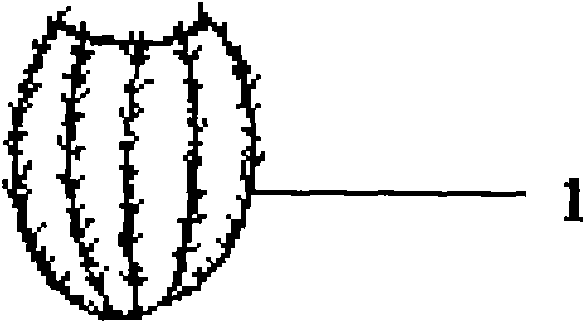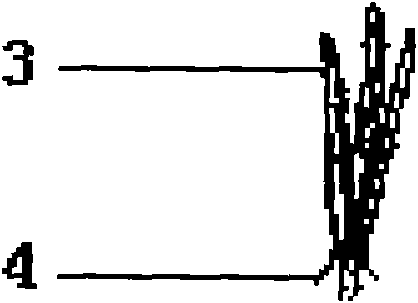Grafting and modeling method for potted ornamental plants
A technology for ornamental plants and bonsai, applied in the fields of botanical equipment and methods, decorative arts, horticulture, etc., can solve the problems of difficult survival of distant grafting, single plant shape, no cambium, etc., to improve ornamental value and economic value. Easy to operate and enhance the effect of resistance
- Summary
- Abstract
- Description
- Claims
- Application Information
AI Technical Summary
Problems solved by technology
Method used
Image
Examples
Embodiment 1
[0033] Grafting of ears of the same species of prickly pear (E. tubiflora)
[0034] 1. Overview
[0035] There are 10 pots of prickly pears with a diameter of 5cm to 8cm and a height of 6cm to 10cm, as rootstocks (see figure 1 ); Another 10 prickly pear seedlings with a diameter of 0.5cm to 1.0cm are used as scions (plant spikes, see Figure 3).
[0036] 2. Grafting shape
[0037] In April, in the middle of the tops of 5 rootstocks, dig a small hole, about 1.0cm~2.0cm deep, with a surface area of about 1.0~2.5cm2, in the shape of a pot; for the other 5 rootstocks, first cut off the top 1.5cm~ 2.5cm long, become a horizontal cross-section, and then dig a small hole on each of them, the specifications and sizes are the same as before (see figure 2 ). The small holes are then filled with moist soil obtained from clean, fertile topsoil from the woodland.
[0038] Then, plant the prickly pear young plants that have been cultivated in advance in the caves of each rootstock, 1...
Embodiment 2
[0043] Heterogeneous Grafting Model of Crab Claw (Z.truncoctus) Plant and Ear
[0044] 1. Overview
[0045] This is the grafting of plants and spikes between different species of cactus. There are 15 prickly prickly pear rootstock pots and bowls, and the specifications are the same as in Example one. 10 days before grafting, 45 crab claw scion (plant ear) seedlings cultivated through cuttings, with a height of 1.5cm to 3.0cm, had just put new roots.
[0046] 2. Grafting shape
[0047] Grafted in April. When planting crab claw ear seedlings, each group of 3 plants is planted in the same hole of the rootstock. Other operating procedures are the same as in Embodiment 1.
[0048] 3. Cultivation management
[0049] Same as embodiment one.
[0050] In the present embodiment, 15 pots of crab claw strain ears were grafted altogether, and a group of 3 crab claw strain ear seedlings were planted in the rootstock cave of each pot. All the above grafts survived, grew normally, and...
Embodiment 3
[0052] Heterogeneous Grafting of Epiphyllum (E.oxypetalum) Plants and Spikes
[0053] 1. Overview
[0054] There are 8 pots of prickly prickly pears with the same specifications and sizes as the rootstocks. Eight epiphyllum young plants are used as scions (plant spikes), with a height of 2.0cm to 5.0cm, and the young roots have been released at the beginning, and the length is about 0.1cm to 0.3cm.
[0055] 2. Grafting shape
[0056] In April, use a pointed bamboo stick or wooden stick to drill a hole about 1.5cm to 2.0cm deep in the middle of the top of the rootstock cactus. The diameter of this cave is slightly larger than the diameter of the panicle of the epiphyllum, and then fill the cave with about 1 cm of moist soil. Then insert the epiphyllum spikes into it, and fill the surrounding gaps with fine soil. Other operating procedures are the same as in Embodiment 1.
[0057] 3. Cultivation management
[0058] Same as embodiment one.
[0059] In this embodiment, there ...
PUM
 Login to View More
Login to View More Abstract
Description
Claims
Application Information
 Login to View More
Login to View More - R&D
- Intellectual Property
- Life Sciences
- Materials
- Tech Scout
- Unparalleled Data Quality
- Higher Quality Content
- 60% Fewer Hallucinations
Browse by: Latest US Patents, China's latest patents, Technical Efficacy Thesaurus, Application Domain, Technology Topic, Popular Technical Reports.
© 2025 PatSnap. All rights reserved.Legal|Privacy policy|Modern Slavery Act Transparency Statement|Sitemap|About US| Contact US: help@patsnap.com



